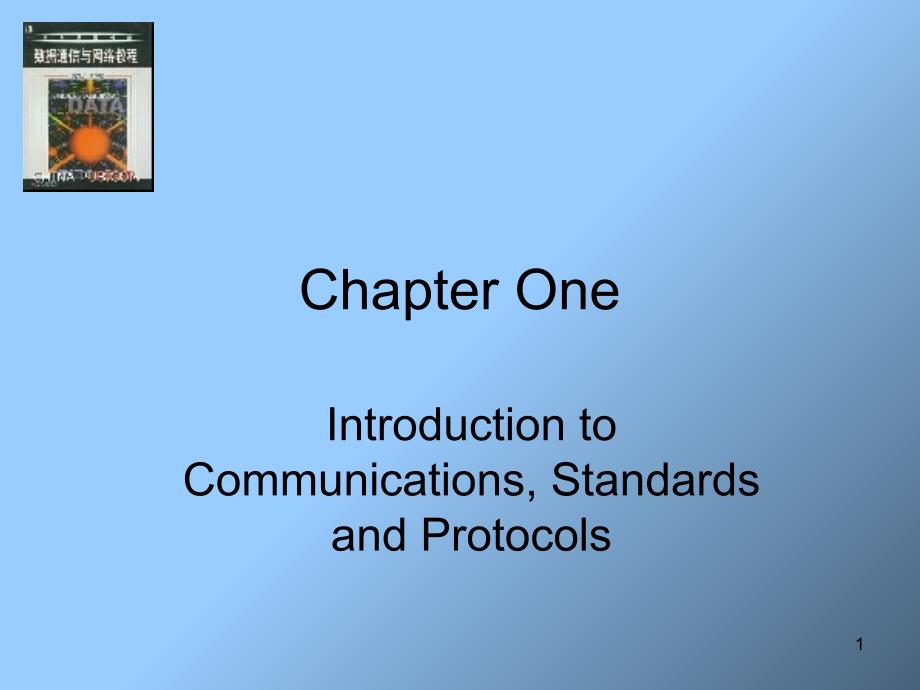 数据教程课件chapter1introdu
数据教程课件chapter1introdu



《数据教程课件chapter1introdu》由会员分享,可在线阅读,更多相关《数据教程课件chapter1introdu(41页珍藏版)》请在装配图网上搜索。
1、Chapter OneIntroduction to Communications,Standards and Protocols1IntroductionWho today has not used a computer network?Mass transit,interstate highways,24-hour bankers,grocery stores,cable television,cell phones,businesses and schools,and retail outlets support some form of computer networkChapter
2、One-Introduction to Communications,Standards,And Protocol2The Language of Computer NetworksComputer network an interconnection of computers and computing equipment using either wires or radio waves over small or large geographic areasLocal area network networks that are small in geographic size span
3、ning a room,floor,building,or campusChapter One-Introduction to Communications,Standards,And Protocol3The Language of Computer NetworksMetropolitan area network networks that serve an area of 1 to 30 miles,approximately the size of a typical cityWide area network a large network that encompasses par
4、ts of states,multiple states,countries,and the worldChapter One-Introduction to Communications,Standards,And Protocol4The Language of Computer NetworksPersonal area network a network of a few meters,between wireless devices such as PDAs,laptops,and similar devicesVoice network a network that transmi
5、ts telephone signalsData network a network that transmits computer dataChapter One-Introduction to Communications,Standards,And Protocol5The Language of Computer NetworksData communications the transfer of digital or analog data using digital or analog signalsTelecommunications the study of telephon
6、es and the systems that transmit telephone signalsNetwork management the design,installation,and support of a network,including its hardware and softwareChapter One-Introduction to Communications,Standards,And Protocol6The Big PictureNetworks are composed of many devices,including:Workstations(compu
7、ters,telephones)ServersNetwork hubs and switches(bridges)Routers(LAN to WAN and WAN to WAN)Telephone switching gearChapter One-Introduction to Communications,Standards,And Protocol7Chapter One-Introduction to Communications,Standards,And Protocol8TopologiesCommon Bus TopologyStar TopologyRing Topolo
8、gyFully Connected TopologyCombined TopologiesChapter One-Introduction to Communications,Standards,And Protocol9LAN Topologies10Common Bus Topology Multipoint medium:contentionTransmission propagates throughout medium Heard by all stationsNeed to identify target stationEach station has unique address
9、Full duplex connection between station and tapAllows for transmission and receptionNeed to regulate transmissionTo avoid collisionsTerminator absorbs frames at end of medium11Frame Transmissionon Bus LAN12Star TopologyEach station connected directly to central nodeUsually via two point to point link
10、sCentral node can broadcastPhysical star,logical busOnly one station can transmit at a timeCentral node can act as frame switch13Ring TopologyRepeaters joined by point to point links in closed loopReceive data on one link and retransmit on anotherLinks unidirectional or bidirectionalStations attach
11、to repeatersData in framesCirculate past all stationsDestination recognizes address and copies frameFrame circulates back to source where it is removedMedia access control determines when station can insert frame(token passing for example)14Frame TransmissionRing LAN15Ring and Star UsageRingVery hig
12、h speed links over long distancesSingle link or repeater failure disables networkStarBest for short distancesHigh data rates for small number of devices16 Combined Topology Fully Connected Topology17Need For StandardsTask broken into subtasksImplemented separately in layers in stackFunctions needed
13、in both systemsPeer layers communicateTypes of StandardsDe facto standardsFormally recognized and adopted by a standards organization18Key Elements of a ProtocolSyntaxData formatsSignal levelsSemanticsControl informationError handlingTimingSpeed matching19Standards OrganizationsIETF:Internet Enginee
14、ring Task ForceIEEE:Institute of Electrical and Electronic Engineer,the largest professional organizationThree models to learn OSI model,Internet layers and TCP/IP protocol suite20Organization of air travela series of stepsticket(purchase)baggage(check)gates(load)runway takeoffairplane routingticket
15、(complain)baggage(claim)gates(unload)runway landingairplane routingairplane routingWHY LAYERING?21ticket(purchase)baggage(check)gates(load)runway(takeoff)airplane routingdepartureairportarrivalairportintermediate air-trafficcontrol centersairplane routingairplane routingticket(complain)baggage(claim
16、gates(unload)runway(land)airplane routingticketbaggagegatetakeoff/landingairplane routingLayering of airline functionalityLayers:each layer implements a servicevia its own internal-layer actionsrelying on services provided by layer below22Dealing with complex systems:explicit structure allows identi
17、fication,relationship of complex systems pieceslayered reference model for discussionmodularization eases maintenance,updating of systemWHY LAYERING?23Overview of the OSI model:Chapter One-Introduction to Communications,Standards,And Protocol24Application layer where the application using the networ
18、k resides.Common network applications include web browsing,e-mail,file transfers,and remote loginsPresentation layer performs a series of miscellaneous functions necessary for presenting the data package properly to the sender or receiverChapter One-Introduction to Communications,Standards,And Proto
19、col25Network Architectures-OSISession layer responsible for establishing sessions between usersTransport layer provides an end-to-end error-free network connection.Makes sure the data arrives at the destination exactly as it left the source.Network layer responsible for creating,maintaining and endi
20、ng network connections.Transfers a data packet from node to node within the network.Chapter One-Introduction to Communications,Standards,And Protocol26Network Architectures-OSIData link layer responsible for taking the data and transforming it into a frame with header,control and address information
21、,and error detection codePhysical layer handles the transmission of bits over a communications channel.Includes voltage levels,connectors,media choice,modulation techniquesChapter One-Introduction to Communications,Standards,And Protocol27Logical and physical connectionsChapter One-Introduction to C
22、ommunications,Standards,And Protocol28Network ArchitecturesLogical and physical connections A logical connection is one that exists only in the software,while a physical connection is one that exists in the hardwareNote that in a network architecture,only the lowest layer contains the physical conne
23、ction,while are higher layers contain logical connectionsChapter One-Introduction to Communications,Standards,And Protocol29Chapter One-Introduction to Communications,Standards,And Protocol30The OSI Environment31Connection Strategies:Circuit Switching:phonesMessage Switching:store and forward networ
24、ksPacket Switching:DatagramVirtual CircuitChapter One-Introduction to Communications,Standards,And Protocol32OSI Layers(1)Physical LayerPhysical interface between devicesMechanicalElectricalFunctionalProcedural33OSI Layers(2)Data Link LayerError detection and correctionParity Bit(even/odd)Media Acce
25、ss ControlCSMA/CDToken PassingToken RingToken BusFlow Control34OSI Layers(3)Network LayerTransport LayerFollow ControlConnection ManagementExchange of data between end systemsSessionControl of dialogues between applicationsDifference from the transport layer connection35OSI Layers(4)Presentation Lay
26、erCode ConversionData CompressionEncryption Application LayerFile Transfer ProtocolWeb BrowingE-mail 36Internet Layersapplication:supporting network applicationsFTP,SMTP,STTPtransport:host-host data transferTCP,UDPnetwork:routing of datagrams from source to destinationIP,routing protocolslink:data t
27、ransfer between neighboring network elementsPPP,Ethernetphysical:bits“on the wire”applicationtransportnetworklinkphysical37messagesegmentdatagramframesourceapplicationtransportnetworklinkphysicalHtHnHlMHtHnMHtMMdestinationapplicationtransportnetworklinkphysicalHtHnHlMHtHnMHtMMnetworklinkphysicallink
28、physicalHtHnHlMHtHnMHtHnHlMHtHnMHtHnHlMHtHnHlMrouterswitchDecapsulationEncapsulation38The TCP/IP Layers:Chapter One-Introduction to Communications,Standards,And Protocol39Network Architectures TCP/IPApplication layer equivalent to OSIs application and presentation layersTransport layer equivalent to
29、 OSIs transport layerNetwork(Internet or internetwork)layer equivalent to OSIs network layerNetwork access(data link/physical)layer equivalent to OSIs data link and physical layersChapter One-Introduction to Communications,Standards,And Protocol40Review Questions:2,8,16Exercises:4,5,13Chapter One-Introduction to Communications,Standards,And Protocol41
- 温馨提示:
1: 本站所有资源如无特殊说明,都需要本地电脑安装OFFICE2007和PDF阅读器。图纸软件为CAD,CAXA,PROE,UG,SolidWorks等.压缩文件请下载最新的WinRAR软件解压。
2: 本站的文档不包含任何第三方提供的附件图纸等,如果需要附件,请联系上传者。文件的所有权益归上传用户所有。
3.本站RAR压缩包中若带图纸,网页内容里面会有图纸预览,若没有图纸预览就没有图纸。
4. 未经权益所有人同意不得将文件中的内容挪作商业或盈利用途。
5. 装配图网仅提供信息存储空间,仅对用户上传内容的表现方式做保护处理,对用户上传分享的文档内容本身不做任何修改或编辑,并不能对任何下载内容负责。
6. 下载文件中如有侵权或不适当内容,请与我们联系,我们立即纠正。
7. 本站不保证下载资源的准确性、安全性和完整性, 同时也不承担用户因使用这些下载资源对自己和他人造成任何形式的伤害或损失。
